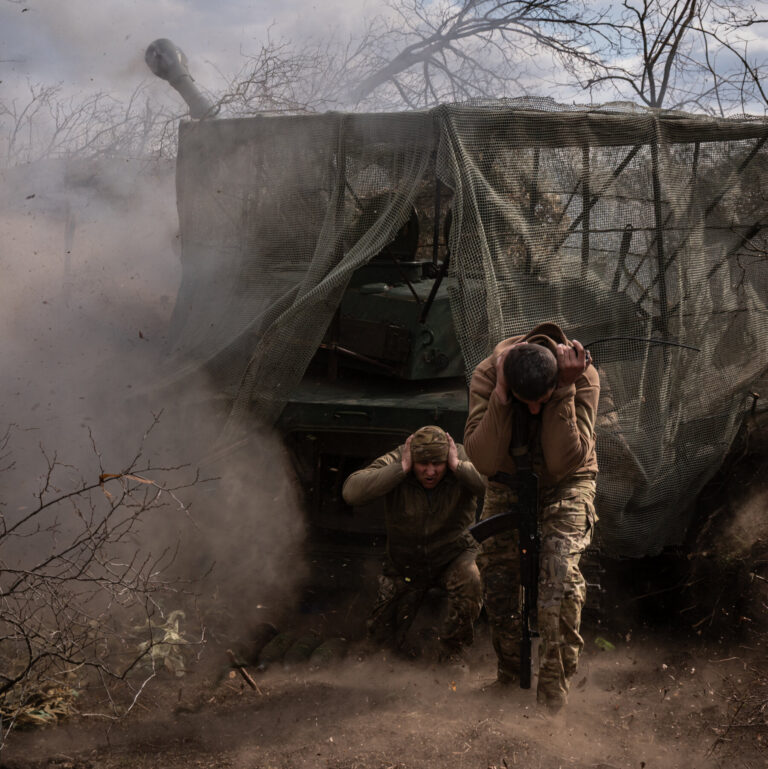Queues for the show snake down the block, with people waiting up to seven hours to buy tickets at the theater in central Kiev. Videos of the performance have attracted millions of views online.
The Big Hit is not a popular Broadway musical or a pop star's concert series: It's a play based on a classic 19th-century Ukrainian novel, “The Witch of Konotop,” and the atmosphere is anything but How optimistic. Consider the opening line: “It's sad and dark.”
Mykhailo Matiukhin, an actor in the production, said this is what struck Ukrainians because it shows “what we are experiencing now.”
“Tragedy comes and takes everything away from you, your love and your home,” he said.
The play dramatizes the story of a Cossack leader in a nearly 400-year-old Ukrainian community as he tries to eradicate witches who local citizens believe are responsible for a drought. The action takes place against the backdrop of a military threat from Tsarist Russia – something that has resonated with today's Ukrainians as they absorb daily, and often disheartening, battlefield news and prepare for modern Russia's missile attacks on their city at night.
Ivan Uryvsky, the director, said audiences were particularly fascinated by the sense of impending tragedy in the play, which is being performed at the Ivan Franko Theater in Kiev.
Rather than seeking an escape from the war, many Ukrainians flocked to see the show to give meaning to their lives, he said.
“It is very difficult to overestimate the harsh reality in which Ukrainians live now, but the theater should feel the mood of the time and people,” Uryvsky said. “When he can do that, then the show will touch people's hearts.”
The show's success also highlights a renewed interest in Ukraine's cultural heritage following Russia's full-scale invasion of the country in February 2022, which has manifested itself in theatre, literature and art. This includes the culture of the Cossacks, the semi-nomadic people who populated the steppes of Ukraine and southern Russia.
“When the war began, a new wave of interest in our history and culture appeared,” said Susanna Karpenko, who composed the music for the show. Ms. Karpenko said she was influenced by Ukrainian folk music and wanted to attract audiences eager to understand their own culture. “This is required in Ukraine now,” she said.
Under the Soviet Union, Russia dominated the territory that is now Ukraine both politically and culturally, and books in Ukrainian were largely banned. After the collapse of the Soviet Union, Russia continued to exert its cultural influence in Ukraine, purchasing radio and television stations, newspapers, and book publishers.
Ukrainians have begun to push back and assert a stronger sense of their own identity, a trend that has grown dramatically with the two Russian invasions of their country – in Crimea and eastern Ukraine in 2014, and with the attack on the entire country in 2022.
After the invasion, Kiev's vibrant theater scene, like many other sources of entertainment, nearly collapsed, as fighting and rocket attacks disrupted normal life and millions of people fled the country.
But the Ukrainian theater recovered. In 2023, 350 new plays were staged across Ukraine, according to theater critic Serhiy Vynnychenko, founder of an online platform that analyzes theater-related data. This is double the number recorded in the first year of the large-scale invasion, although it is still well below the number of shows staged before the Covid pandemic and the invasion.
The “Witch of Konotop” debuted last spring and the buzz around it has continued to grow, as has the demand for tickets this year. The show is now part of the theater's repertoire and there are no plans to conclude it at the moment.
The novel and play, by Hryhorii Kvitka-Osnovianenko, tell the story of Mykyta Zaboha, a Cossack town administrator who falls in love with a beautiful woman who refuses to marry him. Zabroha's anguish at being abandoned is intensified by a terrible drought that has struck his town and, angry at women in general and under the influence of his devious and selfish employee, he decides that it is all the witches' fault.
The play is set in a period in the 1600s, when Tsarist Russia was trying to extend its control over the lands that are now Ukraine. While Zabroha searches for the witches, his superiors order him to send soldiers to fight the Russians.
The prospect of going to war only reinforces the Cossacks' belief that they are weakened by the witches and must be drowned: a task that Zabroha pursues with ruthless energy instead of preparing for war.
The show ends with the villagers discovering a witch after drowning a number of innocent women. But the witch has the last laugh, casting a spell that causes Zabroha to marry an unattractive woman from the village.
He is eventually dismissed by his superiors for neglecting his duties in preparing for defense against the Russians.
The current war against Russia has pushed many young Ukrainians to discover theater for themselves, said Evhen Nyshchuk, the director of the Ivan Franko Theater, which stages classics that usually appeal to older audiences.
In addition to the sold-out shows, posts with the hashtag “The Witch of Konotop” have been viewed 35 million times on TikTok, which is used primarily by young people in Ukraine.
In addition to young people's interest in their history, theater critic Vynnychenko said, many cultural events and concerts they are usually attracted to have been canceled because of the war, leaving them with few entertainment options.
Anastasia Shpytalenko, 15, attended the show one recent evening with a group of friends after waiting in line for five hours to buy tickets. “We heard she was very popular and wanted to try it,” she said.
The show “shows us what our culture really is,” said Daria Filonenko, 15, while another, Anastasia Yakushko, 16, chimed in: “This show is just wow! Sometimes, it seems, the old can be more interesting than the new.
Witches have a strong resonance in Ukrainian culture and are a mainstay of its folk customs. Early in the war, a video of the real city of Konotop in northeastern Ukraine went viral online. He captured a woman approaching a tank as Russian forces advanced into Ukraine. He invokes the witches to challenge the soldiers.
“Do you even know where you are? It's Konotop,” the woman said. “Here every second woman is a witch,” she added before telling a Russian soldier that she would be cursed with impotence.
A Ukrainian pop song about a witch who curses the enemy, written by poet Liudmyla Horova, can often be heard in cafes. “Enemy, you will get what the witch gives you,” the text says.
After two years of war, witch-themed souvenirs and T-shirts have also proliferated across Ukraine. A clothing brand has created a T-shirt depicting a witch dressed in khaki camouflage flying a shoulder-fired anti-tank missile instead of a broom. All this fuels the show's popularity, organizers said.
“Ukrainians,” said Mr. Uryvsky, the theater's director, “are attracted to the image of the witch.”





